Science in the Age of Enlightenment
The history of science during the Age of Enlightenment traces developments in science and technology during the Age of Reason, when Enlightenment ideas and ideals were being disseminated across Europe and North America. Generally, the period spans from the final days of the 16th and 17th-century Scientific Revolution until roughly the 19th century, after the French Revolution (1789) and the Napoleonic era (1799–1815). The scientific revolution saw the creation of the first scientific societies, the rise of Copernicanism, and the displacement of Aristotelian natural philosophy and Galen's ancient medical doctrine. By the 18th century, scientific authority began to displace religious authority, and the disciplines of alchemy and astrology lost scientific credibility.
While the Enlightenment cannot be pigeonholed into a specific doctrine or set of dogmas, science came to play a leading role in Enlightenment discourse and thought. Many Enlightenment writers and thinkers had backgrounds in the sciences and associated scientific advancement with the overthrow of religion and traditional authority in favour of the development of free speech and thought. Broadly speaking, Enlightenment science greatly valued empiricism and rational thought, and was embedded with the Enlightenment ideal of advancement and progress. As with most Enlightenment views, the benefits of science were not seen universally; Jean-Jacques Rousseau criticized the sciences for distancing man from nature and not operating to make people happier.[1]
Science during the Enlightenment was dominated by scientific societies and academies, which had largely replaced universities as centres of scientific research and development. Societies and academies were also the backbone of the maturation of the scientific profession. Another important development was the popularization of science among an increasingly literate population. Philosophes introduced the public to many scientific theories, most notably through the Encyclopédie and the popularization of Newtonianism by Voltaire as well as by Émilie du Châtelet, the French translator of Newton's Philosophiæ Naturalis Principia Mathematica. Some historians have marked the 18th century as a drab period in the history of science;[2] however, the century saw significant advancements in the practice of medicine, mathematics, and physics; the development of biological taxonomy; a new understanding of magnetism and electricity; and the maturation of chemistry as a discipline, which established the foundations of modern chemistry.
Universities
The number of universities in Paris remained relatively constant throughout the 18th century. Europe had about 105 universities and colleges by 1700. North America had 44, including the newly founded
The study of science under the heading of
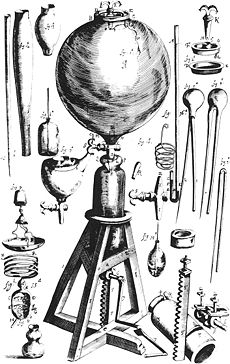
Before the 18th century, science courses were taught almost exclusively through formal lectures. The structure of courses began to change in the first decades of the 18th century, when physical demonstrations were added to lectures. Pierre Polinière and Jacques Rohault were among the first individuals to provide demonstrations of physical principles in the classroom. Experiments ranged from swinging a bucket of water at the end of a rope, demonstrating that centrifugal force would hold the water in the bucket, to more impressive experiments involving the use of an air-pump.[8] One particularly dramatic air-pump demonstration involved placing an apple inside the glass receiver of the air-pump, and removing air until the resulting vacuum caused the apple to explode.[9] Polinière's demonstrations were so impressive that he was granted an invitation to present his course to Louis XV in 1722.[10]
Some attempts at reforming the structure of the science curriculum were made during the 18th century and the first decades of the 19th century. Beginning around 1745, the
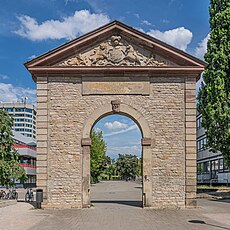
Universities in France tended to serve a downplayed role in the development of science during the Enlightenment; that role was dominated by the scientific academies, such as the
In the 17th century, the
While the number of universities did not dramatically increase during the Enlightenment, new private and public institutions added to the provision of education. Most of the new institutions emphasized mathematics as a discipline, making them popular with professions that required some working knowledge of mathematics, such as merchants, military and naval officers, and engineers.[18] Universities, on the other hand, maintained their emphasis on the classics, Greek, and Latin, encouraging the popularity of the new institutions with individuals who had not been formally educated.[13]
Societies and Academies
Scientific academies and societies grew out of the Scientific Revolution as the creators of scientific knowledge in contrast to the scholasticism of the university.
National scientific societies were founded throughout the Enlightenment era in the urban hotbeds of scientific development across Europe. In the 17th century the
Official scientific societies were chartered by the state in order to provide technical expertise.
Periodicals
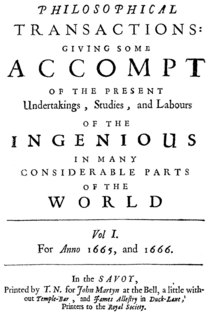
Academies and societies served to disseminate Enlightenment science by publishing the scientific works of their members, as well as their proceedings. At the beginning of the 18th century, the

The limitations of such academic journals left considerable space for the rise of independent periodicals. Some eminent examples include
Some changes in periodicals occurred during the course of the Enlightenment. First, they increased in number and size. There was also a move away from publishing in Latin in favour of publishing in the vernacular. Experimental descriptions became more detailed and began to be accompanied by reviews.
Encyclopedias and dictionaries
Although the existence of
Along with secular matters, readers also favoured an alphabetical ordering scheme over cumbersome works arranged along thematic lines.
The first technical dictionary was drafted by
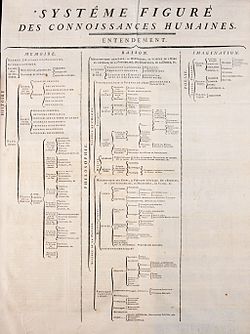
In Germany, practical reference works intended for the uneducated majority became popular in the 18th century. The Marperger Curieuses Natur-, Kunst-, Berg-, Gewerkund Handlungs-Lexicon (1712) explained terms that usefully described the trades and scientific and commercial education. Jablonksi Allgemeines Lexicon (1721) was better known than the Handlungs-Lexicon, and underscored technical subjects rather than scientific theory. For example, over five columns of text were dedicated to wine, while geometry and logic were allocated only twenty-two and seventeen lines, respectively. The first edition of the Encyclopædia Britannica (1771) was modelled along the same lines as the German lexicons.[41]
However, the prime example of reference works that systematized scientific knowledge in the age of Enlightenment were
As an Encyclopédie, it is to set forth as well as possible the order and connection of the parts of human knowledge. As a Reasoned Dictionary of the Sciences, Arts, and Trades, it is to contain the general principles that form the basis of each science and each art, liberal or mechanical, and the most essential facts that make up the body and substance of each.[43]
The massive work was arranged according to a "tree of knowledge". The tree reflected the marked division between the arts and sciences, which was largely a result of the rise of empiricism. Both areas of knowledge were united by philosophy, or the trunk of the tree of knowledge. The Enlightenment's desacrilization of religion was pronounced in the tree’s design, particularly where theology accounted for a peripheral branch, with black magic as a close neighbour.
Popularization of science
One of the most important developments that the Enlightenment era brought to the discipline of science was its popularization. An increasingly literate population seeking knowledge and education in both the arts and the sciences drove the expansion of print culture and the dissemination of scientific learning. The new literate population was due to a high rise in the availability of food. This enabled many people to rise out of poverty, and instead of paying more for food, they had money for education.[47] Popularization was generally part of an overarching Enlightenment ideal that endeavoured “to make information available to the greatest number of people.”[48] As public interest in natural philosophy grew during the 18th century, public lecture courses and the publication of popular texts opened up new roads to money and fame for amateurs and scientists who remained on the periphery of universities and academies.[49]
British coffeehouses
An early example of science emanating from the official institutions into the public realm was the British coffeehouse. With the establishment of coffeehouses, a new public forum for political, philosophical and scientific discourse was created. In the mid-16th century, coffeehouses popped up around Oxford, where the academic community began to capitalize on the unregulated conversation that the coffeehouse allowed.[50] The new social space began to be used by some scholars as a place to discuss science and experiments outside of the laboratory of the official institution.[51] Coffeehouse patrons were only required to purchase a dish of coffee to participate, leaving the opportunity for many, regardless of financial means, to benefit from the conversation. Education was a central theme and some patrons began offering lessons and lectures to others. The chemist Peter Staehl provided chemistry lessons at Tilliard’s coffeehouse in the early 1660s. As coffeehouses developed in London, customers heard lectures on scientific subjects, such as astronomy and mathematics, for an exceedingly low price.[52] Notable Coffeehouse enthusiasts included John Aubrey, Robert Hooke, James Brydges, and Samuel Pepys.[53]
Public lectures
Public lecture courses offered some scientists who were unaffiliated with official organizations a forum to transmit scientific knowledge, at times even their own ideas, and the opportunity to carve out a reputation and, in some instances, a living. The public, on the other hand, gained both knowledge and entertainment from demonstration lectures.[54] Between 1735 and 1793, there were over seventy individuals offering courses and demonstrations for public viewers in experimental physics. Class sizes ranged from one hundred to four or five hundred attendees.[55] Courses varied in duration from one to four weeks, to a few months, or even the entire academic year. Courses were offered at virtually any time of day; the latest occurred at 8:00 or 9:00 at night. One of the most popular start times was 6:00 pm, allowing the working population to participate and signifying the attendance of the nonelite.[56] Barred from the universities and other institutions, women were often in attendance at demonstration lectures and constituted a significant number of auditors.[57]
The importance of the lectures was not in teaching complex mathematics or physics, but rather in demonstrating to the wider public the principles of physics and encouraging discussion and debate. Generally, individuals presenting the lectures did not adhere to any particular brand of physics, but rather demonstrated a combination of different theories.[58] New advancements in the study of electricity offered viewers demonstrations that drew far more inspiration among the laity than scientific papers could hold. An example of a popular demonstration used by Jean-Antoine Nollet and other lecturers was the ‘electrified boy’. In the demonstration, a young boy would be suspended from the ceiling, horizontal to the floor, with silk chords. An electrical machine would then be used to electrify the boy. Essentially becoming a magnet, he would then attract a collection of items scattered about him by the lecturer. Sometimes a young girl would be called from the auditors to touch or kiss the boy on the cheek, causing sparks to shoot between the two children in what was dubbed the ‘electric kiss‘.[59] Such marvels would certainly have entertained the audience, but the demonstration of physical principles also served an educational purpose. One 18th-century lecturer insisted on the utility of his demonstrations, stating that they were “useful for the good of society.” [60]
Popular science in print
Increasing literacy rates in Europe during the course of the Enlightenment enabled science to enter popular culture through print. More formal works included explanations of scientific theories for individuals lacking the educational background to comprehend the original scientific text.
However, science took an ever greater step towards popular culture before Voltaire’s introduction and Châtelet’s translation. The publication of
The influence of science also began appearing more commonly in poetry and literature during the Enlightenment. Some poetry became infused with
Thy swift career is with whirling orbs,
Comparing things with things in rapture loft,
And grateful adoration, for that light,
So plenteous ray'd into thy mind below.[68]
While references to the sciences were often positive, there were some Enlightenment writers who criticized scientists for what they viewed as their obsessive, frivolous careers. Other antiscience writers, including
Women in science
During the Enlightenment era, women were excluded from scientific societies, universities and learned professions. Women were educated, if at all, through self-study, tutors, and by the teachings of more open-minded fathers. With the exception of daughters of craftsmen, who sometimes learned their father’s profession by assisting in the workshop, learned women were primarily part of elite society.[69] A consequence of the exclusion of women from societies and universities that prevented much independent research was their inability to access scientific instruments, such as the microscope. In fact, restrictions were so severe in the 18th century that women, including midwives, were forbidden to use forceps.[70] That particular restriction exemplified the increasingly constrictive, male-dominated medical community. Over the course of the 18th century, male surgeons began to assume the role of midwives in gynaecology. Some male satirists also ridiculed scientifically minded women, describing them as neglectful of their domestic role.[71] The negative view of women in the sciences reflected the sentiment apparent in some Enlightenment texts that women need not, nor ought to be educated; the opinion is exemplified by Jean-Jacques Rousseau in Émile:
A woman’s education must... be planned in relation to man. To be pleasing in his sight, to win his respect and love, to train him in childhood, to tend him in manhood, to counsel and console, to make his life pleasant and happy, these are the duties of woman for all time, and this is what she should be taught while she is young.

Despite these limitations, there was support for women in the sciences among some men, and many made valuable contributions to science during the 18th century. Two notable women who managed to participate in formal institutions were
More commonly, women participated in the sciences through an association with a male relative or spouse.
Many other women became illustrators or translators of scientific texts. In France, Madeleine Françoise Basseporte was employed by the Royal Botanical Garden as an illustrator. Englishwoman Mary Delany developed a unique method of illustration. Her technique involved using hundreds of pieces of coloured-paper to recreate lifelike renditions of living plants. German born Maria Sibylla Merian along with her daughters including Dorothea Maria Graff were involved in the careful scientific study of insects and the natural world. Using mostly watercolor, gauche on vellum, She became one of the leading entomologist of the 18th century. They were also one of the first female entomologists who took a scientific trip to Suriname to study plant life for a total of a five year span.
Noblewomen sometimes cultivated their own botanical gardens, including
Disciplines
Astronomy
Building on the body of work forwarded by
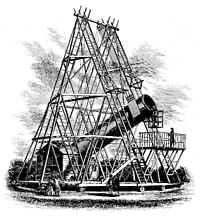
Observations of Venus in the 18th century became an important step in describing atmospheres. During the 1761
However, much astronomical work of the period becomes shadowed by one of the most dramatic scientific discoveries of the 18th century. On 13 March 1781, amateur astronomer
Chemistry
The
Developed under
Lavoisier subsequently discovered and named
See also
Notes
- ^ Burns (2003), entry: 7,103.
- ^ see Hall (1954), iii; Mason (1956), 223.
- ^ Porter (2003), 44.
- ^ Porter (2003), 52.
- ^ Porter (2003), 45.
- ^ Porter (2003), 79-80.
- ^ Burns (2003), entry: 239.
- ^ Sutton, (1995), p. 195.)
- ^ Sutton, (1995), p. 199.
- ^ Sutton, (1995), p. 195.
- ^ Porter, (2003), p. 54.
- ^ Porter, (2003), p. 55.
- ^ a b Burns, (2003), entry: 239.
- ^ Porter, (2003), p. 57.
- ^ Butts, (1955), p. 29.
- ^ Jacob, (1988), pp.52-53.
- ^ Jacob, (1988), pp. 182-187.
- ^ Porter, (2003), p. 73.
- ^ Gillispie, (1980), p. xix.
- ^ James E. McClellan III, “Learned Societies,” in Encyclopedia of the Enlightenment, ed. Alan Charles Kors (Oxford: Oxford University Press, 2003) "Oxford University Press: Encyclopedia of the Enlightenment: Alan Charles Kors". Archived from the original on 2012-03-30. Retrieved 2015-10-16. (accessed on June 8, 2008).
- ^ Porter, (2003), p. 90.
- ^ Porter, (2003), pp. 90-91.
- ^ Porter, (2003), p. 91.
- ^ Gillispie, (1980), p. xxiii.
- ^ See Gillispie, (1980), "Conclusion".
- ^ Daston, (1998), p. 71
- ^ Gillispie, (1980), p. xxi.
- ^ a b c d Burns, (2003), entry: 199.
- ^ Porter, (2003), p.95.
- ^ McClellan, (2003), pp. 11-18
- ^ Lynn, (2006), p.16
- ^ Porter, (2003), p. 195
- ^ Schectman, (2003), p. xxxvii.
- ^ Porter, (2003), p.96.
- ^ Headrick, (2000), p. 144.
- ^ Headrick, (2000), p. 172.
- ^ Porter, (2003), pp. 249-50.
- ^ Headrick, (2000), p. 144
- ^ Headrick, (2000), p. 168)
- ^ Headrick, (2000), p. 172
- ^ Headrick, (2000), pp. 150-152.
- ^ Headrick, (2000), p. 153.
- ^ d'Alembert, p. 4.
- ^ Darnton, (1979), p. 7.
- ^ Darnton, (1979), p. 37.
- ^ Darnton, (1979), p. 6.
- ^ Jacob, (1988), p. 191; Melton, (2001), pp. 82-83
- ^ Headrick, (2000), p. 15
- ^ Headrick, (2000), p. 19.
- ^ Cowen, (2005), p. 91.
- ^ Cowen, (2005), p. 106.
- ^ Cowen, (2005), p. 99.
- ^ Cowen, (2005), pp. 96-109.
- ^ For a detailed analysis of public lectures, see Geoffrey Sutton, Science for a Polite Society: Gender, Culture, and the Demonstration of Enlightenment (Colorado: Westview Press, 1995). Margaret Jacob offers a more specific analysis of lecturers in Holland and England in The Cultural Meaning of the Scientific Revolution ( New York: Knopf, 1988).
- ^ Headrick, (2000), p. 19
- ^ Headrick, (2000), pp. 26-27
- ^ Headrick, (2000), p. 18
- ^ Headrick, (2000), pp. 29-31
- ^ Sutton, (1995), pp. 304-305.
- ^ Headrick, (2000), p. 34
- ^ Porter, (2003), p. 300.
- ^ Porter, (2003), p. 101.
- ^ Phillips, (1991), pp. 85, 90
- ^ Phillips, (1991), p. 90.
- ^ Phillips, (1991), p. 92.
- ^ Phillips, (1991), p. 107.
- ^ a b Burns, (2003), entry: 158.
- ^ Thomson, (1786), p. 203.
- ^ Kors, (2003), “Education”
- ^ Whitehead, (1991), p. 227.
- ^ a b c Burns, (2003), entry: 253.
- ^ Kors, (2003), “Education.”
- ^ Phillips, (1991), p. 161.
- ^ Porter, (2003), p. 328.
- ^ Turner, (1963), p. 88.
- ^ Hoskin, (1999), p. 174.
- ^ Mason, (1962), p. 297.
- ^ Schectman, (2003), pp. xxxvii, xl.
- ^ Schectman, (2003), p. xxxvi.
- ^ Schectman, (2003), p. xlii.
- ^ Littmann, (2004), p. 11.
- ^ Parker, (1991), p. 4.
- ^ Silver, (1998), p. 460.
- ^ Olby, (1990), p. 265.
- ^ See H. Butterfield, "Chapter 11" of The Origins of Modern Science: 1300–1800 (New York: Macmillan, 1957) for this traditional view.
- ^ Perrin, (1988), pp. 32-81.
- ^ a b Idhe, (1964), p. 61
- ^ Conant, (1950), p. 14.
- ^ Idhe, (1964), pp. 68-69
- ^ Conant, (1950), p. 12.
- ^ Olby, (1990), p. 273.
- ^ Olby, (1990), p. 264.
- ^ Olby, (1990), pp. 274-5.
- ^ McClellan, (2006) p. 301
References
|

